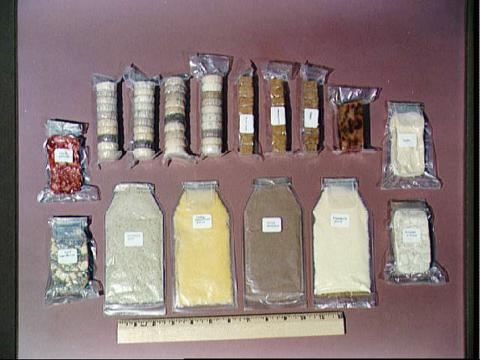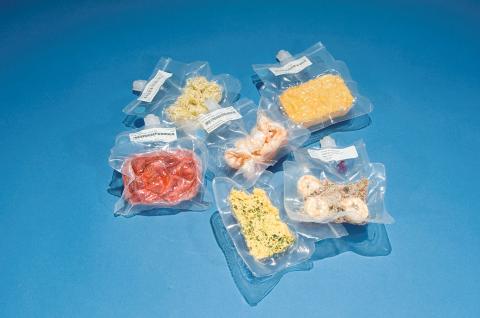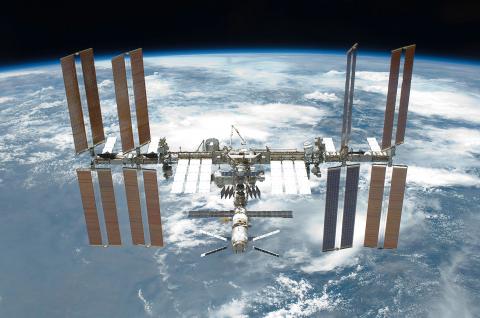Mike Kuo (郭正光) wasn’t in Penghu’s Jhenhai Junior High School (鎮海國中) last week to discuss politics; instead he talked about testing water filters in zero gravity and developing sweet-and-sour pork for astronauts.
The former president of the US-based Formosa Association for Public Affairs may be known to Taipei Times readers for his opinion pieces, but Kuo also spends part of his visits to Taiwan talking to students about his 38-year career as a food scientist for NASA.
Kuo joined NASA in 1980, when it was recruiting for food experts for its Space Shuttle program, which launched its first flight in April 1981. His presentation is a fascinating journey from the 1960s, where astronauts munched on dry compressed chicken powder, to the modern day where they can enjoy fresh vegetables and chef-created meals.

Photo courtesy of Mike Kuo
Although nutrition, such as making up for calcium loss which is faster in space, is the main objective, Kuo says a significant part is to find ways to satisfy the astronauts’ appetites. His team has developed at least 80 types of food and 20 drinks over the years, covering the cuisine of the diverse crew on the International Space Station (ISS).
“For example, someone wanted sweet-and-sour pork, so we freeze dried fried pork and experimented with sugar, vinegar and tomato powder,” Kuo says. “We try to make their dining experience as similar to the conditions on Earth as possible. Eating is one of their main sources of enjoyment up there.”
SPACE FOOD EVOLUTION

Photo courtesy of Mike Kuo
Space food has come a long way, as Kuo shows photos of how it has evolved over the decades. It’s evident that the food scientists aren’t just trying to simulate food on Earth, but also the dining environment. Instead of just sucking out what looks like baby food from a packet in the early days, Kuo says they want the astronauts to be able to sit down and eat properly.
They even tried using hard plastic containers to resemble bowls at one point, but found it too heavy and bulky.
“It costs US$10,000 to send one pound of material into space,” Kuo says. “We have to minimize what they bring.”

Photo courtesy of Mike Kuo
All food needs to last at least two years. A photo of a standard meal includes Chessmen cookies, kidney beans, a sausage patty, pudding, Life Savers candy and lemonade. The innovations in the field continue, as astronauts can now grow fresh vegetables on board, and in October last year ISS astronauts were able to use 3D bioprinting to create artificial beef.
Kuo says that at first, his team designed strict daily meals for the astronauts to make sure they were getting adequate nutrition. But after finding out that many weren’t following the plan, NASA switched to a bar code system so they could at least track what the astronauts ate and advise accordingly.
Astronauts have reported that their taste buds tend to dull in space, and many reports show that they prefer sharper and spicier foods — evidenced with the immense popularity of Tabasco sauce aboard the ISS. While astronauts can also add salt and pepper water to their food, Kuo says too much salt can increase calcium loss, which is one of the major nutritional issues in zero gravity.

Photo courtesy of Mike Kuo
PRACTICAL ISSUES
Kuo spent at least five years testing ways to reduce calcium loss through diet. His team found that they could simulate space calcium loss conditions on Earth by having people lie down at a certain angle, and paid homeless people to serve as test subjects from four to 26 weeks.
Besides eating less meat and taking osteoporosis medication, they found that there was not much they could do, Kuo says.

Photo courtesy of Mike Kuo
For the past decade up until his retirement in 2018, Kuo focused on providing a steady source of drinkable water in space. With the end of the Space Shuttle program in 2011, it became more difficult to transport water to astronauts. Plus, the technology was also needed if the US wanted to build long-term space stations on the moon or Mars.
Kuo helped develop a three-step filtration system to purify the astronauts’ urine — currently their technology can recover 80 percent of the water and levels purer than drinking water found on Earth. He shows a picture of two astronauts toasting to their own urine. Interestingly, up until at least 2015, the Russians on the ISS refused to drink their own urine, using a different filtration system that dealt with other wastewater.
The most exciting opportunity for Kuo brought by this project was the chance to experience zero gravity, since the filtration machines needed to be tested in space conditions. The scientists would get into a plane that would launch at a steep angle and then abruptly level. This creates a 25 to 30 second window of weightlessness that Kuo had to test his machines. The plane could repeat this maneuver up to 40 times a day.

Photo courtesy of Wikimedia Commons
“I’m very proud of having the chance to do this,” Kuo says, adding that while he had two vomit bags on him during the process, he never threw up. “I don’t think many Taiwanese have experienced zero gravity.”

Most heroes are remembered for the battles they fought. Taiwan’s Black Bat Squadron is remembered for flying into Chinese airspace 838 times between 1953 and 1967, and for the 148 men whose sacrifice bought the intelligence that kept Taiwan secure. Two-thirds of the squadron died carrying out missions most people wouldn’t learn about for another 40 years. The squadron lost 15 aircraft and 148 crew members over those 14 years, making it the deadliest unit in Taiwan’s military history by casualty rate. They flew at night, often at low altitudes, straight into some of the most heavily defended airspace in Asia.

This month the government ordered a one-year block of Xiaohongshu (小紅書) or Rednote, a Chinese social media platform with more than 3 million users in Taiwan. The government pointed to widespread fraud activity on the platform, along with cybersecurity failures. Officials said that they had reached out to the company and asked it to change. However, they received no response. The pro-China parties, the Chinese Nationalist Party (KMT) and Taiwan People’s Party (TPP), immediately swung into action, denouncing the ban as an attack on free speech. This “free speech” claim was then echoed by the People’s Republic of China (PRC),

Many people in Taiwan first learned about universal basic income (UBI) — the idea that the government should provide regular, no-strings-attached payments to each citizen — in 2019. While seeking the Democratic nomination for the 2020 US presidential election, Andrew Yang, a politician of Taiwanese descent, said that, if elected, he’d institute a UBI of US$1,000 per month to “get the economic boot off of people’s throats, allowing them to lift their heads up, breathe, and get excited for the future.” His campaign petered out, but the concept of UBI hasn’t gone away. Throughout the industrialized world, there are fears that

Like much in the world today, theater has experienced major disruptions over the six years since COVID-19. The pandemic, the war in Ukraine and social media have created a new normal of geopolitical and information uncertainty, and the performing arts are not immune to these effects. “Ten years ago people wanted to come to the theater to engage with important issues, but now the Internet allows them to engage with those issues powerfully and immediately,” said Faith Tan, programming director of the Esplanade in Singapore, speaking last week in Japan. “One reaction to unpredictability has been a renewed emphasis on